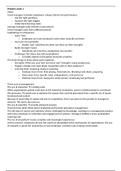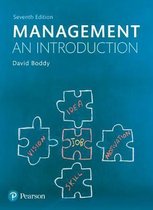Problem week 1
Video:
Great managers translate employees’ unique talents into performance.
- Ask the right questions
- Squeeze the right triggers
- Understand learning styles
Average managers play checkers (same pieces)
Great managers play chess (different pieces)
Capitalizing on Uniqueness:
- Saves Time
o Employees are more productive when tasks naturally suit them
- Increases Accountability
o People ‘own’ what they do when you focus on their strengths
- Builds Stronger Teams
o Individuals see how they complement one another
- Challenges the Status Quo (old assumptions)
o A healthy degree of disruption promotes creativity
The three things to know about each employee
- Strengths: What was your best and worst day? Strengths trump weaknesses.
- Triggers: People care most about recognition (who is their audience?)
- Learning Style: Analysing, doing or watching
o Analysers learn from: Role-playing, Postmortems, Breaking tasks down, preparing
o Doers learn from: Specific tasks, independence, trial and error
o Watchers learn from: Seeing the whole picture, shadowing top performer
Three eras of management
The era of execution Creating scale
When organizations gained scale (due to the industrial revolution), owners needed people to coordinate
the processes. The goals was to optimize the output that could be generated from a specific set of inputs.
Command-and-control
Because of ownership of capital and lack of competition, there was place for the growth of managerial
theories. This led to the next era.
The era of expertise provide advanced services
Theories from other fields where implanted and formed operations management.
The old ways of control and authority where challenged by knowledge, resulting in a management practice
with more emphasis on motivation and engagement of workers. Managers fulfilled a more participative
coaching role.
The era of empathy Create complete and meaningful experiences
At this moment, employees all over the world are dissatisfied at the mechanisms of organizations. The era
of empathy is about the uniqueness of each employee, emotions and creating communities.
,Chapter 1 Managing in Organisations
1.0 Management knowledge and management skills
Management skills Identifiable sets of actions that individuals perform to produce an outcome they value.
5 steps to develop skills ALAPA
1. Assessment: Show learners their present level of skill +
motivate improvement
2. Learning: Knowing the research/theory showing why the skill
is valuable
3. Analysis: Linking skills with achieved results
4. Practice: practice and adapt skills to suit the way they work.
Feedback enables further improvement
5. Application: Using new skills in practical situations.
1.1 Introduction
Entrepreneurs thrive on innovation as they try to make the most
of opportunities. Managers in established businesses deal with how to meet more demand with fewer resources.
The role of management is to add value to resources.
1.2 Managing to add value to resources
Organisation A social arrangement for achieving goals that create value.
Tangible resources Physical assets of an organisation such as plant, people and finance.
Intangible resources Non-physical assets such as information, reputation and knowledge.
Competences Skills and abilities that an organisation uses to deploy resources effectively, such as
systems, procedures and ways of working.
Value Added to resources when they are transformed into goods or services that are worth
more than their original cost plus the cost of transformation.
Innovation is the discipline of management, the thought and practice that makes organisations work.
There are three management practices: (1) targets, (2) incentives and (3) monitoring. Managers build an
organisation with the resources and competences to deliver goods and services. Commercial organisations create
wealth by adding value to resources. Investing capital to generate cash flows. Some management issues arise in all
organisations, while others are unique to their setting. The value an organisation creates depends on how well
people understand their situation and use that knowledge to develop the right resources and competences.
1.3 Meanings of management
Management is both a universal human activity and a distinct role. When business is growing and making profit,
managers are born. Tony Watson said that we should not really see these two roles as separate.
Management as a Occurs whenever people take responsibility for an activity and consciously try to
universal human activity shape its progress and outcome.
Manager Someone who gets things done with the aid of people and other resources.
Management Activity of getting things done with the aid of people and other resources.
Management as a Develops when activities previously embedded in the work itself become the
distinct role responsibility not of the employee, but of owners or their agents.
Role Sum of the expectations that others have about the responsibilities of a person
occupying a position.
1.4 Specialisation between areas of management
Functional managers are either line managers or staff managers.
Middle managers Translating strategy into operational tasks,
mediating between senior management vision and operational
reality – and often interpreting and re-shaping higher policies to
suit local conditions. They may also help develop strategy by
presenting information about customer expectations to senior
managers.
Some senior managers (CEO, CFO) are also part of the board of
directors. The board usually includes non-executive directors
(senior managers from other companies.
General manager Responsible for the performance of a distinct unit of the organisation. Relies on the
, managers in charge of each function.
Functional manager Responsible for the performance of an area of technical or professional work.
Line manager Responsible for the performance of activities that directly meet customers’ needs.
Staff manager Responsible for performance of activities (finance, personnel) that support line managers.
Project manager Responsible for managing a project (temporary team), usually intended to change some
element of an organisation or its context.
Entrepreneur People who see opportunities in a market, and quickly mobilise the resources to deliver
the product or service profitably.
1.5 Influencing through the process of managing
Stakeholders will have different priorities, so managers need to influence them to act in ways they believe will add
value. This can be done directly by interpersonal skills or indirectly by the (1) process of managing, (2) task of
managing or (3) shaping the context. Management work is fragmented and interrupted.
There are five profiles for managers based on how they spend their time (Rosemary Stewart):
1. Emissaries: Most time out of the organisation, meeting customers, suppliers or contractors
2. Writers: Most time alone reading and writing, having the fewest contacts
3. Discussers: Most time with other people and with their colleagues
4. Trouble-shooters: Fragmented work pattern, with many brief contacts, especially subordinates
5. Committee members: Most internal contacts, and spent much time in formal meetings.
Henry Mintzberg, saw ten management role’s in three categories. In
real life, managers combine these rules (dependent on character,
position in hierarchy and type of business)
Some people argue that two roles are missing from this list which are:
Manager as subordinate (at the top) and manager as worker (if you have managers above you). Managers in small
businesses have the same roles, brevity and fragmentation as in large organisations, but with more informal
communication and non-managerial activities.
Stakeholders Individuals, groups or organisations with an interest in, or who are affected by, what the
organisation does.
Networking Behaviours that aim to build, maintain and use informal relationships (internal and external)
that may help work related activities. This can be done face-to-face or social media networks.
Success Relatively rapid promotion. Successful managers spent more time networking.
Effective Work-unit performance and subordinates’ satisfaction. Effective managers spent most time on
communication and HRM.
1.6 Influencing through the tasks of managing
A second way in which managers influence others is when they manage the transformation of resources into more
valuable outputs.
Managemen Planning, organising, leading and controlling the
t tasks use of resources to add value to them.
External Dependence on tangible and intangible resources
environment and the perceived value of customers
Planning Overall direction of the work (performance
objectives, forecasting future trends and
assessing resources).
Organising How to allocate time and effort
Leading Task of generating effort and commitment
(influencing, motivating and communicating)
whether with individuals or in teams.
, Controlling Task of monitoring progress, comparing it with
plan and taking corrective action (does it reach
the (financial) objectives?) Good managers create
and use opportunities to learn from what they
are doing.
1.7 Influencing through shaping the context
Internal context Context in organisation (8 elements).
Historical context What happened in the past shapes us in the
present and influences our future.
External context Micro (competitive) and macro (general)
Gulick and Urwick expanded upon the existing managing functions,
and created the acronym POSDCORB (planning, organizing, staffing,
directing, coordinating, reporting, and budgeting).
Managers use one of 3 theories of
the link between their context and their action
1. Determinism Context is independent variable, describes the assumption that factors
in the external context determine an organisation’s performance.
2. Choice Context is dependent variable, people influence events and shape their
context.
3. Interaction Context and managers interpret existing context and change it according
to personal objectives.
1.8 Thinking critically to develop knowledge and skill
Four components of critical thinking: (1) Identifying and challenging assumptions, (2) Recognising the importance of
context (uncritically thinking Ideas/ methods in one context will work in others) (3) Imagining and exploring
alternatives and (4) Seeing limitations
Critical Identifies the assumptions behind ideas, relates them to context, imagines alternatives and recognises
thinking limitations. Positive activity that enables people to see several possibilities and not a single path. It
helps you develop both knowledge and skills.
1.9 Integrating themes
Entrepreneurs depend heavily on a network of informal contacts
Sustainability traditionally measured in economic terms, but now in the triple bottom line.
Sustainability Economic activities that meet the needs of the present population while preserving the
environment for the needs of future generations.
Triple bottom line The idea that organisations can assess their performance on social and environmental
criteria as well as financial ones. People, planet and profit.
People The social account, measured by the impact of the organisation on the quality of lives
Planet The environmental account, measured by the environmental impact of the organisation
Profit The economic account, measured by profitability, return on assets etc
Internationalisation Developments in communication technology and international trade have led to an increase
in the amount of trade that crosses national borders. There are some challenges in matching different cultures.
Governance Corporate governance can prevent reputation damage.
Corporate Concerned with ensuring that internal controls adequately balance the needs of financial
governance interest and other interests of stakeholders.






